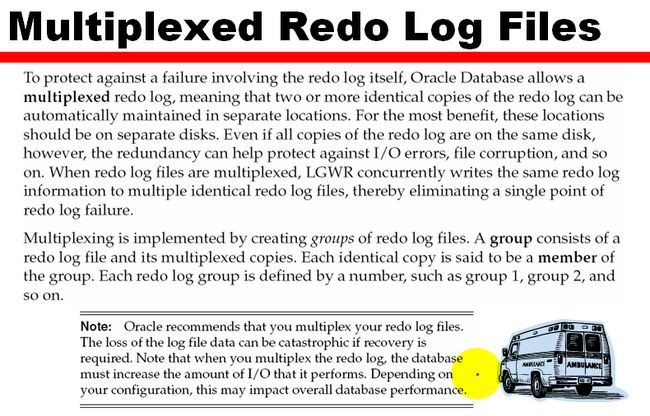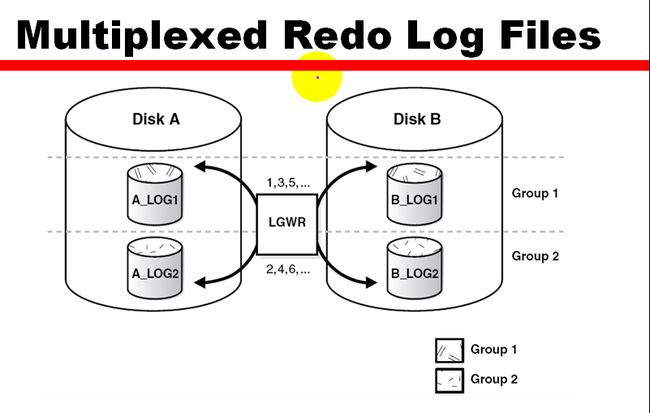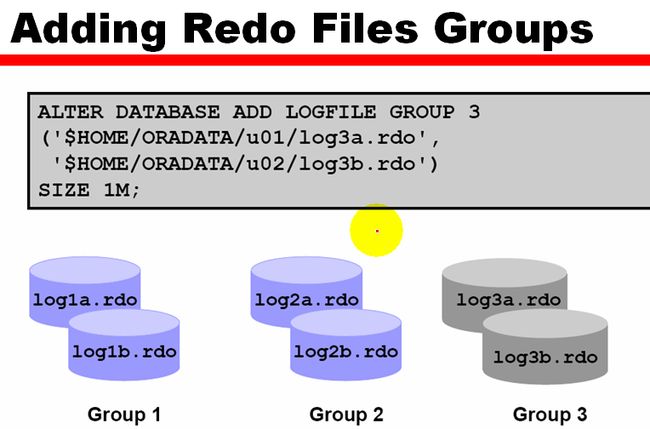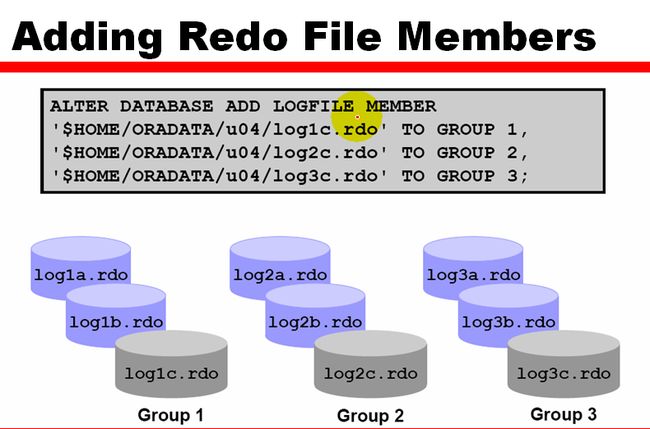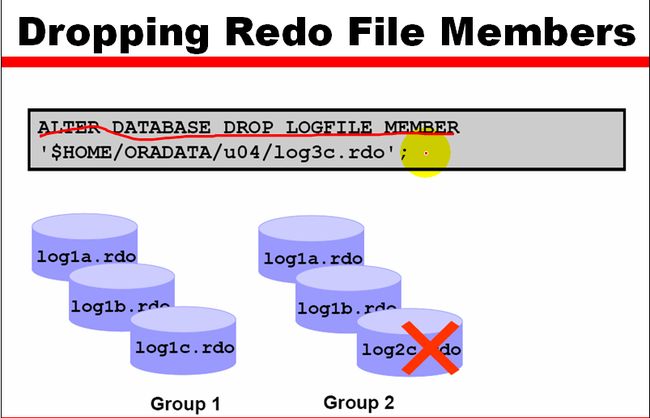ORACLE-基础五(online redo log)
Online Redo Log Files
Online Redo log files have the following characteristics:
Record all changes made to data
Provide a recovery mechanism
Can be organized into groups
At least two groups required
Online Redo Log File Groups
A set of identical copies of online redo log files is called an online redo log file group
The LGWR backgroundprocess concurrently writes the same information to call online redo log files in a group
The Oracle server needs a minimum of two online redo log file groups for the nomal operation of a database
Online Redo Log File Members
Each online redo log file in a group is called a member
Each member in a group has identical log sequence numbers and are of the same size.
The LSN(log sequence number ) is assigned each time that the Oracle server writes to a log group to uniquely identify each online redo log file
How Redo Files Work
Online Redo log files are used in a cyclic fashion
When a online redo log file is full , LGWR will move to the next log group
Called a log swith
Checkpoint operation also occurs
Information wirtten to the control file
The act of switching from one log file group to the other is called a log swith . A checkpoint is the writing of dirty(modified ) blocks from the buffer cache to disk
When will LGWR write redo?
When a transaction commits
Every three seconds
When the Redo Log Buffer becomes one-third full
When there is more than a megabyte of changed records in the Redo Log Buffer.
Before the DBWn writes modified blocks in the Database Buffer Cache to the data files
Force Log Switches $CK
Forcing a log switch
ALTER SYSTEM SWITCH LOGFILE
Checkpoints can be forced by :
FAST_START_MTTR_TARGET=600
ALTER SYSTEM CHECKPOINT
(select group#, thread#,sequence#,status from v$log)
Dropping Redo File Members
An instance always requires at least two vlid groups of redo log files, regardless of the number of members in the groups.(A group comprises one or more members ) If the member you eant to drop os the last valid member of the group ,you cann't drop the member until the other members become valid. To see a redo log file status, use the v$LOGFILE view, A redo log file becomes INVALID if the database cannot access it .Itbecomes STALE if the databse suspects that it is not complete or correct. A tale log file becomes valid again the next time its group is made the active group.
you cn drop a redo log member only if it is not part of an active or current group. If you want to drop a member of an active group, first force a log switch to accur.
Make sure the group to which a redo log member belongs is archived (if archiving is enabled) before dropping the member. To see whether this has happed,use the V$LOG view
When a redo log member is dropped from the database, the operating system file is not deleted from disk.Rather, the control files of the associated database are updated to dorp the member from database structure.After dropping a redo log file, make sure that the dorp completed successfully, and then use the appropriate operating system command to delete the dropped redo log file.
Dropping Redo Files Groups
An active or current group cannot be dropped .
When an online redo log file group is dropped, the operating system files are not deleted
Alter DATABASE DROP LOGFILEGROUP 3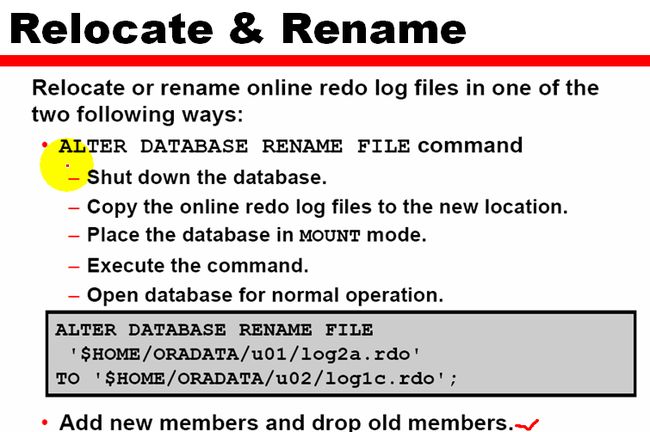
Clear Redo Files
ALTER DATABASE CLEAR LOGFILE command can be used to reinitialize an onlie redo log file
ALTER DATABASE CLEAR LOGFILE GROUP 2Use the UNARCHIVED keyword to avoid archiving the corrupted online redo log file
ALTER DATABASE CLEAR UNARCHIVED LOGFILE GROUP 2
if only one members in a Redo groups available , Oracle can continue Work.
V$LOG Displays the redo log file information from the control file
V$LOGFILE Identifies redo log groups and memebers and members status
V$LOG_HISTORY Cantains log history information
Archived Redo Log files
Filled online redo log files can ben archived
there are two advantages in running the database in ARCHIVELOG mode and archiving online redo lgo files:
Recovery: A database backup together with online and archived redo log files can guarantee recovery of all committed transactions
Backup: This can the performed while the database is open
By defualt, the database is created in NOARCHIVELOG mod
can view through v$instance or v$database
Archived Redo Log Files
Accomplished automatically by ARCn
Accomplished manually through SQL statements
When successfully archived:
An entry in the control file is made
Records:archive log name, log sequence number, and high and low system change number (SCN)
Filedd online redo log files cannot be reused until:
Acheckpoint has taken place
File has been archived by ARCn
Can be multiplexed
Maintained by the DBA
ALTER DATABASE ADD LOGFILE GROUP 3 ('$HOME/ORDATA/u01/log3a.rdo','$HOME/ORDATA/u01/log3b.rdo') SIZE 1M;
ALTER DATABASE ADD LOGFILE MEMBER '$HOME/ORDATA/u01/log1.rdo' TO GROUP 1, '$HOME/ORDATA/u01/log2.rdo' TO GROUP 2;
ALTER DATABASE DROP LOGFILE MEMBER '$HOME/ORDATA/u01/log1.rdo';
ALTER DATABASE DROP LOGFILEGROUP 3
ALTER DATABASE RENAME FILE '$HOME/ORDATA/u01/log1.rdo' TO '$HOME/ORDATA/u01/log2.rdo'
ALTER DATABASE CLEAR LOGFILE GROUP 2
ALTER DATABASE CLEAR UNARCHIVED LOGFILE GROUP 2

